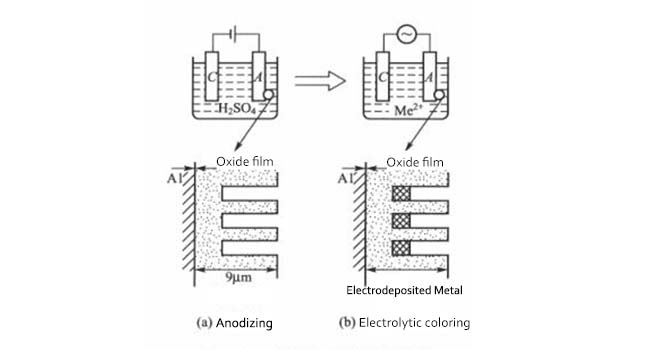- Email: sales@flait-aluminum.com
- Tel: 0086-13203837398
Anodizing of aluminum plate can improve the corrosion resistance, surface hardness and wear resistance of aluminum alloy products. After coloring treatment, it also has a better decorative effect than aluminum plate. Common in life are 1060 anodized aluminum plate, 3003 anodized aluminum plate, 5052 anodized aluminum plate and 6061 anodized aluminum plate. So what is the process flow of anodized aluminum plate? In this article, we will explore it together.

 Cleaning
CleaningClean the oil, dust and other impurities on the surface of the aluminum plate to ensure the surface is clean to ensure the quality of the anodizing effect.
 Pickling
PicklingImmerse the aluminum plate in an acidic solution for pickling treatment to remove the oxide scale, oxide, etc. on the surface of the aluminum plate to improve the anodizing effect.
 Anodizing
Anodizing◆ 1. Anodizing tank preparation:
Put the aluminum plate in the anodizing tank to ensure that the surface of the aluminum plate is in good contact with the treatment tank electrode.
◆ 2. Electrolyte preparation:
Select an appropriate electrolyte, such as sulfuric acid, aluminum sulfate, etc., and adjust the temperature, concentration and other parameters as needed.
◆ 3. Electrolytic reaction:
By applying a DC power supply, an electrolytic reaction is carried out in the anodizing tank to form an oxide film on the surface of the aluminum plate.
◆ 4. Electrolytic time control:
The anodizing time is controlled according to the requirements, generally ranging from tens of minutes to several hours.
◆ 5. Oxide film thickness control:
The thickness of the oxide film is controlled by adjusting parameters such as electrolytic time and current density to meet different needs.
For example, increasing the anodizing time can increase the thickness of the oxide layer, while shortening the oxidation time will obtain a shallower oxide layer.
In addition, selecting a suitable current density can accelerate the growth rate of the film and shorten the anodizing time within a certain range, but when it exceeds a certain value, the film formation rate will decrease instead.
 Coloring
ColoringThe coloring of the anodized film can be divided into electrolytic coloring and chemical coloring.
◆ Electrolytic coloring:
The anodized aluminum plate is subjected to secondary electrolysis in an electrolytic solution containing metal salts. Under the action of the electric field, heavy metal ions enter the pores of the oxide film and are reduced and deposited at the bottom of the pores, so that the oxide film produces bronze, brown, gray, and red, cyan, blue and other tones.
◆ Chemical coloring:
The aluminum plate after anodizing enters into the organic or inorganic dye solution, and the dye penetrates into the pores of the oxide film, resulting in chemical or physical coloring.

 Sealing
Sealing◆ 1. Sealing treatment:
Put the anodized or colored aluminum plate into the sealing liquid to seal the micropores in the anodized layer to improve the corrosion resistance and sealing performance of the aluminum plate.
◆ 2. Cleaning and drying:
Wash the sealed aluminum plate with clean water to remove the residual sealing agent or dye, and ensure that the surface is dry.
Original Source:https://www.flait-aluminum.com/Anodized-Aluminum-Sheet-Coil.html